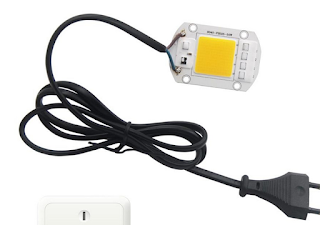LED Driver Roundup
LEDs being current, rather than voltage operated devices require special driver circuits for optimal performance. While simple applications like an indicator light that might be run at a fraction of it's rated capability, a series current limiting resistor is sufficient. High power application running at the edge of the LED's max current rating require active regulation to compensate for the negative temperature coefficients of the LED, (measurement techniques are discussed in this university lab paper.)
Low power LEDs can be driven with simple series resistor current control when powered from a regulated power supply. The LED Load Line graph below helps one select a standard resistor value to get the ballpark current setting with a 5 volt power source. Find where your LED's color line intersects the desired current, then pick the closest resistance line below that intersection.
(This graph is from LEDnique.com, a collection of basic articles on LEDs aimed at students.)
Simple Single Channel Analog Constant Current Regulators.

NSI45020 2 lead, fixed 20mA constant current regulator (different current parts available)
If you are ohms law impaired or lack an assortment of resistors, this part ma simplify life.
With a 24V power supply it can drive from 1 to 7 white (3.3v) LEDs in series,
while staying with the 460mw dissipation limit (with the worst case being a single LED).
Uses Self-Biased Transistor (SBT) technology, behaves similar to a Constant Current Diode.
Max output voltage 45V (min. internal voltage drop 1.6V)
The 3.2mm spaces surface mount tabs are more challenging to solder than resistor leads,
PCB traces are require to meet the 460mw dissipation spec.
(Does not tolerate reverse voltage, watch your connection)
(Paid $0.20 ea)
A newer 2 lead device, the AL5809 handles 60 volts and has 11 different current options and higher dissipation packages, they sell at mainstream distributors for about $0.42 - $0.57.
AMC7135 fixed 350mA Constant Current Chip
(works like the 2 lead device but adds a ground connection)

2.7V~6V operating voltage suitable for USB or battery powered 1W LED.
(paid $0.12 ea)
 | ||
| Some AMC7135 circuit variations |
CN5711 30-1500MA adjustable LED Driver, 2.8V to 6V input voltage.
Suitable for driving a 3 watt single element LED from USB or battery power.
This chip appeals to me because it can be PWM modulated at the CE input by a GPIO pin (as can a simple "logic gate" a MOSFET), but with added current regulation.
(could not find the PWM frequency limit spec.)
This 5mm chip 8 pin chip has .27mm spaced leads and a center head sink pad. Making it
a greater soldering challenge.
(you can buy these chips for about $0.20 ea)
A 5711 regulator on a board is available for about $1.89

A similar device, the AMC7140 handles 750mA, 50+ volts.
SM2082B or CYT1000B Line Voltage Compatible Adjustable Linear Constant Current LED Driver IC
* Single resistor adjustable output current: 5mA - 60mA, 250V max input.
* Can operate from line voltage with 1 bridge rectifier and 1 resister.
(Power factor improved to 90% with ripple filter capacitors)
The 10mm overall length chip package uses just 3 pins by powering internal circuits through the LED drive pin, appears to have a 6.5V internal voltage drop, limiting it's usability in low voltage circuits.
[In order to prevent LED thermal runaway, the chip reduces current when temp over 110 C. is detected]
 |
| Typical Household Light Bulb Internals using SM2082B |
Parallel Constant Current Regulators
These simple constant current devices can be paralleled to multiply the supplied current,there is no problem with mis-match of calibrations, you can parallel a 20 mA with a 40mA.
One low tech engineered flashlight driver uses 8-AMC7135 chips for 8 x .350 = 2.8 Amps drive.
( Using an ATTINY13 processor for "firmware")
Crazy 32 AMC7135 chips paralleled for 12.1A flashlight power.
- - - Switching Constant Current "Buck Converter" Devices - - -
Most line powered LED fixtures use buck converters acting as constant current drivers, encapsulated modules are typically far more expensive than the LEDs.
Chinese open frame components are a bit cheaper. but likely not UL approved.
 |
| 3W to 50W line powered LED drivers $2.50-$13.00 |
7 - 30V, 3W, 700mA / 1W 350mA LED Lamp Driver PWM Dimmer $1
PWM input frequency limit 20khz. Buck converter-Constant Current LED driver, current adjusted with sense resistor and inductor value adjustment, smaller current changes can be made by changing resistors alone. | |
| Using PT4115 Buck Converter Chip, Rated 30V, 1.2A, 5000:1 Dimming |
"Driverless" High Power LEDS may be the most economical Solutions
They run directly off line voltage using built in current regulators50 Watt White LED, ready to wire to 110VAC can be had for under $4.20
(seen for $1.60 ea in lots of 20)
I would carefully insulate the enclosure and probably add a fuse to this hot circuit light.
Driverless LED Teardown Video found BP5132H chips were used.
 |
| 50W, 110AC Powered LED |










Comments
Post a Comment